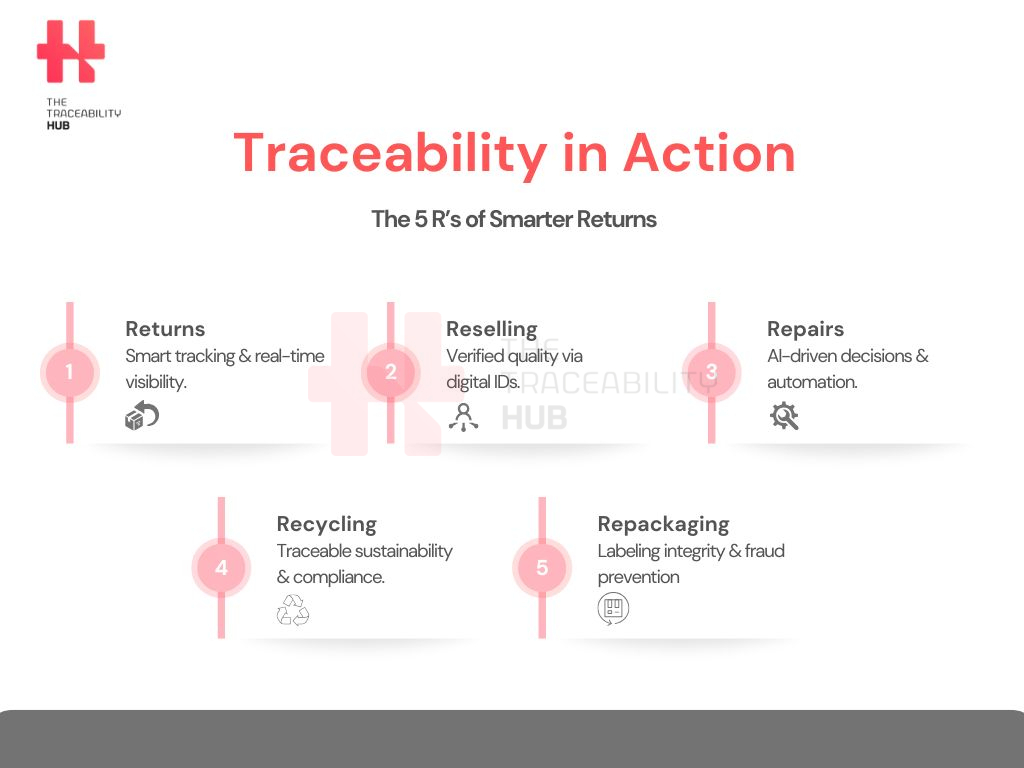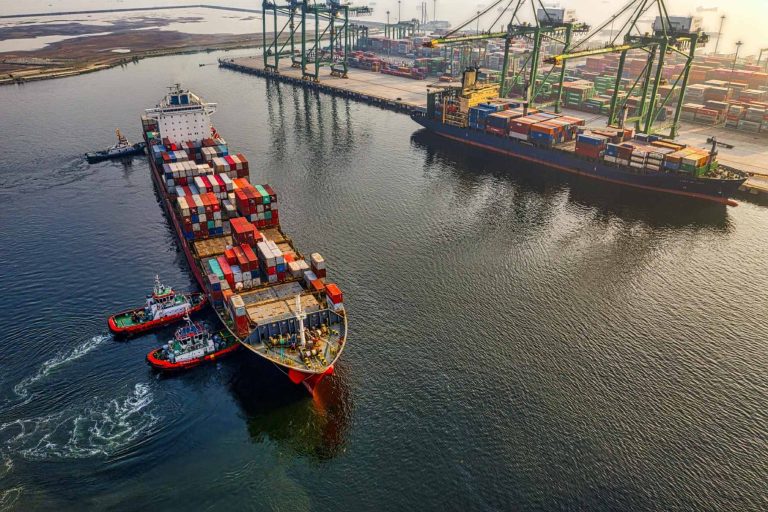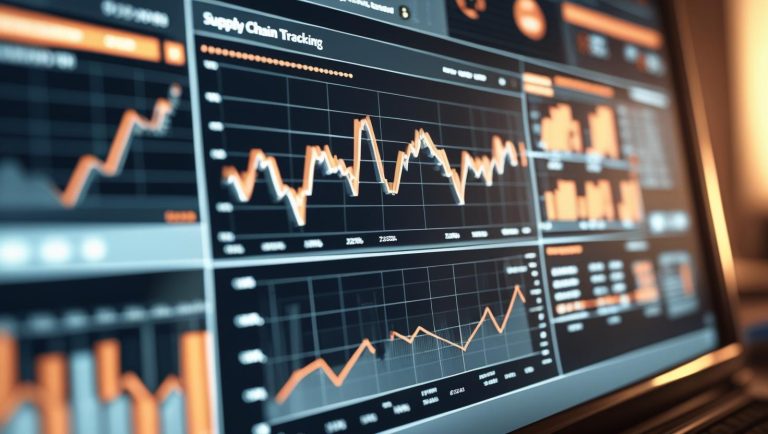Reverse Logistics Traceability
The role of logistics cannot be reduced to the mere transport of products but must be extended to the management of a complex process, made up of various activities (logistical but also productive), and decision-making hubs that require advanced planning capabilities.
The development of this paradigm requires additional skills (for example for the management of serialization, additional services and new forms of packaging), which will lead to a further leap in quality of the supply chain. Transportation visibility is a key priority for shippers, logistics providers and their customers.
With the surge in online shopping and providing hassle-free returns the norm, reverse logistics has become a crucial part of business for all parties in the logistics chain, including retailers, manufacturers, and e-commerce brands.
At the heart of reverse logistics are the “5 Rs”:
- Returns
- Reselling
- Repairs
- Recycling
- Repackaging
Managing all of this might sound simple, but it’s far from it. This is where reverse logistics traceability technologies step in. They help companies navigate the often-complicated world of returns, speeding up the process sustainably and transparently, all while maintaining customer trust.
But let’s face it, product returns management can be a major challenge. Companies are dealing with:
- Return fraud detection: Fake returns and tampered goods are costing businesses billions.
- Inventory Chaos: Poor tracking means warehouses can end up overstuffed or running on empty without warning.
- Environmental Waste: Inefficient product returns can lead to excess waste in landfills and unnecessary emissions.
Tracking and monitoring is often complementary to real-time transportation visibility platforms. Granular data is collected in near real time from the carrier and other sources that manage transportation data, also using Internet of Things (IoT) sensors, tracking devices or tags. To stay competitive, businesses need a smarter, more transparent, tech-driven way to handle returns, and that’s exactly where traceability comes in.
The Growing Complexity of Reverse Logistics
Returned Goods Tracking: Return Rates Are Skyrocketing
Especially in e-commerce, E-commerce returns traceability are becoming the norm.
Everybody expects seamless shopping experience, therefore no hassle, preferably free, returns process. Popular products often returned to retailers are clothing, gadgets, and home goods. Present customers expect returns to be free and swift. This pushes brands to improve tracking of the ever-increasing volume of returned products.
E-commerce returns rates sit between 20% and 30%, while in-store returns likely hover around 8% to 10%. The boom in online shopping has brought a huge rise in product returns, and with “free returns” policies in full swing, those numbers are only going up.
Traceability in Returns Management: Challenges from High Return Volumes
- Operational inefficiencies – Managing massive product returns can lead to warehouse congestion and processing delays.
- Sustainable reverse logistics and rising transportation costs – The price tag for reverse shipping is far higher than standard deliveries.
- Environmental concerns – Many returned items end up in landfills due to poor handling or inability to resell or reuse them.
On top of that, there’s mounting pressure to have a more sustainable reverse logistics. Consumers and governments are demanding that brands reduce waste and embrace a circular economy. It means an economy where products are reused, repaired, or recycled instead of tossed. Social sustainability is an increasingly relevant topic, even in logistics.
Technological and digital innovation, and therefore Logistics 4.0, plays an important role in supporting social sustainability, for example in improving the working conditions of operators and reducing their stress.
Traditional Returns Systems Are Breaking Down
The old ways of managing returns just aren’t cutting it anymore. Product manual tracking, slow processing, and product loss are still common.
And let’s not forget, it’s costly. Without real-time visibility, businesses are losing money, products, and, worst of all, customer trust.
Traceability technology offers a much better way forward.
Traceability in Action: The 5 R’s of Smarter Returns

The Role of Traceability in Reverse Logistics
Across the supply chain there are many information: in-transit shipment, asset, customer and inventory insights at the product and/or cargo level, asset insights, domestic and international: tracking and monitoring solutions track and verify the location, status and potential condition or position of the asset, product or goods in the logistics flow.
Real-Time Tracking Reverse Logistics
With advanced tools like IoT sensors, RFID for returns tracking tags, companies can now track returned products in real time. It circumvents wondering where that missing package went. Real-time return tracking via RFID for returns tracking and IoT-based labels provides greater inventory visibility, making the process much more efficient.
The main data sources are:
- 5G sensors in trailers and attached to products
- IoT devices
- Mobile devices
- Temperature trackers
- Devices transmitting location and condition via cellular connectivity
- Devices connected via Bluetooth
- RFID devices
- Tags, trackers or devices installed or placed in the product, pallet or trailer/container.
Some information required are on location, temperature, light sensitivity, humidity, pressure, elevation, shock, trailer door opening and orientation. While location data can be derived from GPS, Wi-Fi, Bluetooth or cell tower.
Returns Traceability System: Smart Labelling and Unique IDs
By tagging every product with QR codes, RFID for returns tracking chips, or serial numbers, brands essentially give each item a “digital identity”, making processing returns seamless. No more guessing games when it comes to return handling.
Smart Tracking Reverse Logistics: Data-Driven Decisions
AI is helping companies make smarter decisions by analyzing return patterns. Should a product be restocked, repaired, refurbished, or recycled?
With AI-powered reverse logistics, the guessing game is gone. The technology also helps brands better understand their customers, enabling them to predict who’s likely to return items.
Reverse Logistics Traceability Optimization Through Technology
AI-Powered Reverse Logistics and Machine Learning
AI doesn’t just predict which products are most likely to be returned, it also helps companies plan everything from warehouse space to staffing.
Robots in Reverse Logistics and Automated Processing
Robots are helping speed up the sorting and handling of returns, cutting labor costs and getting products back on shelves (or into recycling) much faster.
Blockchain Reverse Logistics for Security
Blockchain reverse logistics offers a secure, tamper-proof record of every return, making it easier to spot fraud and verify product authenticity. That’s a huge win especially for businesses dealing with high-value items.
The Circular Economy & Sustainable Returns Management
Circular Supply Chain Traceability: Giving Products a Second Life
Not every returned product needs to end up in the trash. Thanks to Circular supply chain traceability, companies can resell, refurbish, or recycle returned items. Thus, reducing their environmental impact and recovering some value in the process.
For example, Patagonia’s Worn Wear program takes gently used outdoor gear and resells it, extending its lifecycle and keeping it out of landfills. Also The North Face is supporting environmental causes. They pride themselves on sustainable practices that help the suppliers in their supply chain to reduce their environmental impact as well.
Sustainable Reverse Logistics: Smarter, Greener Logistics
Sustainability doesn’t stop at product reuse. It’s about optimizing the entire returns process. AI-powered route optimization reduces unnecessary transportation miles, which helps cut emissions. DHL’s GoGreen Plus initiative, for example, uses AI-driven logistics to lower emissions in returns management.
Regulatory Compliance Reverse Logistics: Staying Ahead of the Rules
New regulations, like Extended Producer Responsibility (EPR), are pushing businesses to take responsibility for their products even after they’re sold. Traceability helps brands stay on top of these rules and stay proactive in their sustainability efforts.
Industry Use Cases: How Companies Are Implementing Traceable Reverse Logistics
Zara’s Circular Fashion Program and Circular Supply Chain Traceability
Zara is leading the way in sustainable fashion with digital product passports and recycling labels. Customers can return old clothes for resale or recycling, helping Zara close the loop and reduce waste.
IKEA’s Smarter Returns and Circular Supply Chain Traceability
IKEA is also on top of the Sustainable reverse logistics game, using RFID for returns tracking and blockchain to manage returned furniture. Their Circular Hub resells at a convenient price, or refurbishes, lightly used items, giving them a second life and making the entire process more transparent.
Future Trends in Reverse Logistics Traceability
AI-Powered Reverse Logistics Returns Platforms
AI is about to take over. Soon, it will automate nearly every step of the reverse logistics process. Right from the moment a customer requests a return to when the product is resold, repaired, or recycled.
Blockchain Reverse Logistics
Expect blockchain to become the standard for verifying returns and fighting fraud across global supply chains. Transparency will be the name of the game.
Greener Reverse Supply Chains
The future of reverse logistics is sustainable: carbon-neutral returns, minimal packaging, and smarter, waste-free operations powered by traceable tech.
Reverse Logistics Traceability: Why Traceability Matters More Than Ever
Reverse logistics traceability isn’t just about sending products back; it’s about making it smarter and more efficiently. Companies embracing traceability cut costs, win customer loyalty, and build greener, more streamlined businesses.
In short, if you want to thrive in the future of commerce, getting your returns right with traceability at the heart of it is non-negotiable.
Read more: Blockchain & Traceability: When and Why It’s Needed






